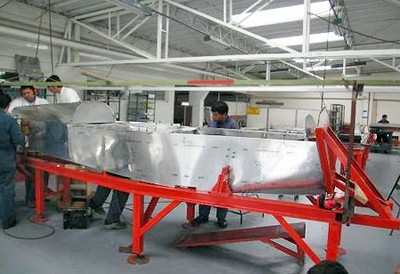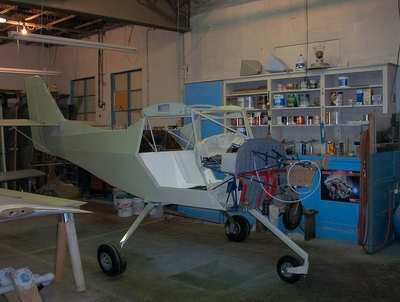Think How Much Went Into Building -- Or Rebuilding -- It
By ANN Senior Correspondent Kevin R.C. "Hognose" O'Brien
How many hours go IN to an airplane? Homebuilders will tell you
it's not the 300 or 600 often claimed by kit airplane
manufacturers. Even the most reputable designers and vendors make
these laughable claims; Aircraft Spruce ads used to tell you to
budget 600 hours for your Rutan Vari-Eze. Will everyone who built
an -Eze in 600 hours raise his right hand? Uh-huh, I figured as
much.

The "mode" or most common answer I've gotten over the years,
when asking that "hours" question, is some variation of, "Oh,
goodness gracious. I don't dare to add it up!" The next most common
answers are nice round numbers like "2,000" and "4,000." The
precise, exacting cynic will tell you it cost him, "3,253 hours,
$39,617.41, and Mabel and the kids -- so far."
That kind of builder takes the same perverse pride in adversity
that a marathoner does in overcoming cramps on Heartbreak Hill.
Pleasure is where you find it.
Of course, not everybody builds like homebuilders. During the
frenzy of war production in 1940-45, a pile of raw materials and
subassemblies might have been rolling on to the test flight ramp as
a completed airplane less than a hundred hours from the time the
production manager put its build number on the schedule. The
multiplicative power of many hands and industrial machinery
shouldn't be underestimated.
And then there are more than the manufacturer's hours in an old
airplane -- there are the hours spent keeping it up. Or, God help
you, the hours spent bringing it back. I've seen planes fly that
short years before were rusting on a Eurasian lakebed, and we all
know the story of Glacier Girl, Don Shoffner's P-38E which recently
was featured at Airventure. Decades of abandonment, years of
restoration, moments of delight.
Tell me again why we do this?
Karl Marx used to believe that the only value in something was
the sum of the human labor that produced it -- he called this the
"Labor Theory of Value," and it's as dead as phrenology or
Lysenkoism everywhere except universities, which preserve it for
some inexplicable reason.
To disprove the Labor Theory of Value you only need to look at
the planes for sale by warbird sales guru Mark Clark's Courtesy
Aircraft.
Some incredibly beautifully restored planes are selling for
relatively short money -- a TBM Avenger, the plane President George
H.W. Bush flew as a young Navy lieutenant, has an asking price
lower than a new Mooney -- even though the Avenger has had an
extremely thorough restoration.
The ultimate restoration was probably Glacier Girl, which
essentially has been built twice: once by Lockheed, and once by
Shoffner's restoration crew, which de-riveted the whole thing,
replacing over 99% of the factory rivets. The team included a small
army of mechanics -- peaking at three full-timers and a manager on
the books at one time. I don't know how many hours were involved.
Literally millions of dollars worth, plus inordinate amounts of
volunteer labor.

Shoffner will never recover the $3+ million he has spent on his
airplane, but the reward that Glacier Girl brings him doesn't
figure in Marx's academic calculus. But when you see Glacier Girl
fly, with Steve Hinton at the controls, you ought to think for a
moment of the workers that did everything from buck those thousands
of rivets, to make endless calls and visits in search of rare parts
and tools. And to Don Shoffner, who first earned, and then spent,
the money to make the plane new.
Volunteer labor is the muscle that moves historic aviation's
wings. Evergreen Aviation Museum, in McMinnville, Oregon, keeps
track of its volunteers' hours: 221 volunteers currently contribute
to the Museum, and 195,965 hours of volunteer effort have been
booked since the museum and Michael King Smith Educational
Institute opened its doors in 2001, 58,215 hours in 2004 alone. Not
all of those hours are spent doing restoration work, but the Museum
has a figure for the hours that are: 48.992 since opening.
You plane might not be historic, but think of the hours that
have gone into building and maintaining her. How many maintenance
hours? Well, as a rule of thumb, average the labour hours of your
last few annuals and multiply times the airplane age in years.
Also, if the plane's had hundred-hour inspections (if it was used
commercially) then add those too. For example, the high time crown
in my fleet is held by a plane built in 1978. In those 26 years,
it's amassed 17,000 airframe hours, about 654 hours a year; and
it's always been in revenue service, so it will have received 170
100-hour inspections in that time. That's a lot of maintenance
hours.

Airliners don't do 100-hour and annual inspections the way we do
in general aviation -- they undergo stage checks. You know how many
hours are in a D check? Me either. I bet it's more, at least more
man-hours, than the sum of all those 100-hours.
Next time you settle into a pilot seat, whether you're lucky
like our friend who's going to be flying the right seat in a
perfectly restored B-25 this week, or just starting out like our
traffic pilots who are strapping on elderly, weary 152s, give a
thought to not just how many hours are on the plane, but how many
hours are in the plane.
You might start her with a little bit more respect this
time.
 ANN's Daily Aero-Linx (05.06.25)
ANN's Daily Aero-Linx (05.06.25) ANN's Daily Aero-Term (05.06.25): Ultrahigh Frequency (UHF)
ANN's Daily Aero-Term (05.06.25): Ultrahigh Frequency (UHF) ANN FAQ: Q&A 101
ANN FAQ: Q&A 101 Classic Aero-TV: Virtual Reality Painting--PPG Leverages Technology for Training
Classic Aero-TV: Virtual Reality Painting--PPG Leverages Technology for Training Airborne 05.02.25: Joby Crewed Milestone, Diamond Club, Canadian Pilot Insurance
Airborne 05.02.25: Joby Crewed Milestone, Diamond Club, Canadian Pilot Insurance





